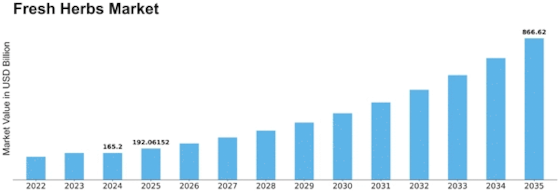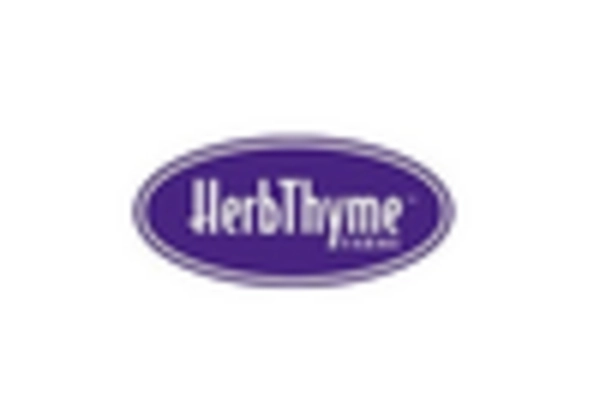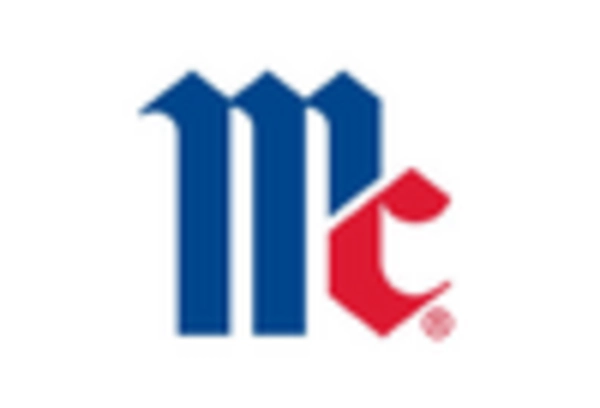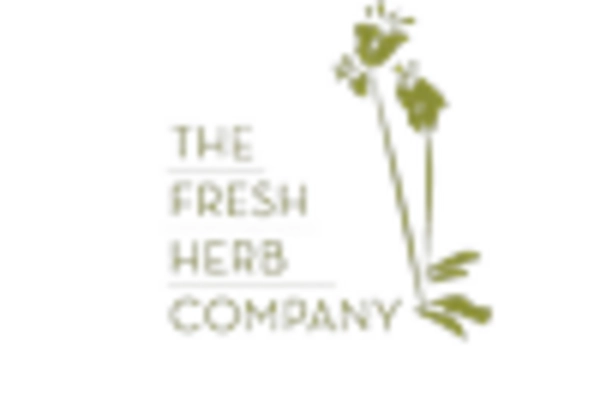Fresh Herbs Size
Fresh Herbs Market Size

Searching...


What is the current valuation of the Fresh Herbs Market as of 2024?
The Fresh Herbs Market was valued at 165.2 USD Billion in 2024.
What is the projected market valuation for the Fresh Herbs Market in 2035?
The Fresh Herbs Market is projected to reach 866.62 USD Billion by 2035.
What is the expected CAGR for the Fresh Herbs Market during the forecast period 2025 - 2035?
The expected CAGR for the Fresh Herbs Market during 2025 - 2035 is 16.26%.
Which segment of fresh herbs had the highest valuation in 2024?
In 2024, Parsley had the highest valuation among fresh herbs, reaching 35.0 USD Billion.
How do organic and conventional fresh herbs compare in terms of market valuation?
In 2024, the market valuation for conventional fresh herbs was 132.16 USD Billion, while organic fresh herbs reached 33.04 USD Billion.
Who are the key players in the Fresh Herbs Market?
Key players in the Fresh Herbs Market include McCormick & Company, Dole Food Company, and Fresh Herbs Company, among others.
As per MRFR analysis, the Fresh Herbs Market Size was estimated at 165.2 USD Billion in 2024. The Fresh Herbs industry is projected to grow from 192.06 USD Billion in 2025 to 866.62 USD Billion by 2035, exhibiting a compound annual growth rate (CAGR) of 16.26% during the forecast period 2025 - 2035.
The Fresh Herbs Market is experiencing robust growth driven by health consciousness and culinary trends.
| 2024 Market Size | 165.2 (USD Billion) |
| 2035 Market Size | 866.62 (USD Billion) |
| CAGR (2025 - 2035) | 16.26% |
| Largest Regional Market Share in 2024 | North America |
<p>McCormick & Company (US), Dole Food Company (US), Fresh Herbs Company (US), Herb Thyme Farms (US), Mann's Fresh Vegetables (US), The Fresh Herb Company (US), Basilur Tea (LK), Greenhouse Organic (CA), Holly's Fresh Herbs (US)</p>
The Fresh Herbs Market is currently experiencing a dynamic evolution, driven by a confluence of consumer preferences and culinary trends. As individuals increasingly seek fresh, natural ingredients, the demand for herbs has surged. This shift is not merely a fleeting trend; it reflects a broader movement towards healthier eating habits and a desire for enhanced flavor profiles in everyday cooking. Retailers and producers are adapting to these changes, exploring innovative ways to present fresh herbs to consumers, including pre-packaged options and ready-to-use formats. Furthermore, the rise of home cooking and gourmet food preparation has contributed to the growing popularity of fresh herbs, as they are perceived as essential components in elevating dishes. In addition to changing consumer behaviors, the Fresh Herbs Market is also influenced by sustainability considerations. Many consumers are becoming more conscious of the environmental impact of their food choices, leading to a preference for locally sourced and organic herbs. This trend encourages producers to adopt sustainable farming practices, which may enhance the appeal of their products. As the market continues to evolve, it appears poised for further growth, with opportunities for innovation in cultivation, distribution, and marketing strategies. The interplay between health consciousness, culinary exploration, and sustainability will likely shape the future landscape of the Fresh Herbs Market.
The emphasis on health and wellness is reshaping consumer preferences, leading to an increased interest in fresh herbs. These ingredients are often associated with various health benefits, prompting individuals to incorporate them into their diets more frequently.
A growing awareness of environmental issues is driving consumers to seek sustainably sourced and locally grown fresh herbs. This trend encourages producers to adopt eco-friendly practices, which may enhance their market appeal.
As more individuals engage in home cooking, there is a notable rise in the use of fresh herbs to enhance flavor and presentation. This trend reflects a broader culinary exploration, where consumers experiment with diverse cuisines and ingredients.
The Fresh Herbs Market is experiencing a notable increase in demand for organic herbs, driven by consumer preferences for healthier and more sustainable food options. According to recent data, the organic herb segment has shown a growth rate of approximately 10% annually. This trend is largely influenced by heightened awareness regarding the health benefits associated with organic produce, including reduced pesticide exposure and enhanced nutritional value. As consumers become more discerning about their food choices, the Fresh Herbs Market is likely to see a continued shift towards organic offerings, prompting producers to adapt their cultivation practices accordingly. This shift not only caters to consumer preferences but also aligns with broader agricultural trends emphasizing sustainability and environmental responsibility.
The Fresh Herbs Market is significantly influenced by evolving culinary trends that emphasize gourmet cooking and the use of fresh ingredients. As consumers increasingly seek to replicate restaurant-quality meals at home, the demand for fresh herbs has surged. Data indicates that the culinary herb segment has expanded by approximately 15% in recent years, reflecting a growing interest in diverse cuisines and flavor profiles. This trend is further supported by the rise of cooking shows and social media platforms that promote culinary exploration. Consequently, the Fresh Herbs Market is poised to benefit from this heightened interest in gourmet cooking, as consumers are more inclined to experiment with various herbs to enhance their culinary creations.
The Fresh Herbs Market is witnessing a surge in interest surrounding home gardening, particularly among urban dwellers. This trend is characterized by a growing number of individuals cultivating their own herbs, driven by a desire for fresh, homegrown produce. Recent statistics suggest that home gardening has increased by over 20% in urban areas, as people seek to reconnect with nature and enhance their culinary experiences. This movement not only promotes self-sufficiency but also contributes to the overall growth of the Fresh Herbs Market, as consumers are more likely to purchase herb plants and seeds from local suppliers. The rise of home gardening reflects a broader societal shift towards sustainability and a preference for locally sourced ingredients.
The Fresh Herbs Market is experiencing a transformation due to the rapid growth of e-commerce and online retailing. As consumers increasingly turn to online platforms for their grocery needs, the demand for fresh herbs available through these channels has risen. Recent data indicates that online grocery sales have surged by approximately 30%, with fresh produce, including herbs, being a significant category. This shift towards digital shopping is reshaping the Fresh Herbs Market, as retailers adapt their strategies to meet consumer preferences for convenience and accessibility. The expansion of e-commerce not only facilitates greater market reach for producers but also enhances consumer access to a wider variety of fresh herbs, thereby driving overall market growth.
The Fresh Herbs Market is significantly impacted by the increasing awareness of health benefits associated with various herbs. Consumers are becoming more informed about the nutritional properties of herbs, which are often rich in vitamins, antioxidants, and anti-inflammatory compounds. Research indicates that certain herbs, such as basil and parsley, can contribute to improved health outcomes, leading to a growing incorporation of these ingredients into daily diets. This heightened awareness is driving demand within the Fresh Herbs Market, as consumers actively seek out herbs that can enhance their overall well-being. As health trends continue to evolve, the market is likely to see an uptick in the popularity of herbs known for their medicinal properties.
<p>The Fresh Herbs Market segmentation, based on type, includes Basil, Chives, Coriander, Parsley, Mint, and Others. The basil segment dominates the market, accounting for the largest market revenue as it is the most commonly utilized ingredient for the preparation of soups, fish, potatoes, and other dishes. Further, it is also used as garnishing and in salads, vegetable stocks, sandwiches, creamy sauces, soup, and omelets. There is an increasing awareness of consumer's preference for medicinal herbs as it helps to reduce cholesterol and triglycerides and also contain magnesium that relaxes the muscles and blood vessels to enhance circulation.</p>
<p>There is an increased demand from the <a href="https://www.marketresearchfuture.com/reports/organic-food-beverages-market-2524">food and beverage industry </a>for herbs because of the rising demand of consumers for natural and clean-labeled products. Furthermore, the chives segment of fresh herb types is expected to be the fastest growing during the forecast years.</p>
<p>The Fresh Herbs Market segmentation, based on category, includes Conventional and Organic. The conventional segment dominates the market, and the organic segment is expected to be the rapid growing during the forecast period because of the increasing demand for organic and natural products from consumers. The herbs that are produced organically are devoid of chemicals and are cultivated under strict guidelines and supervision for maintaining low-to-zero chemical concentration and purity. These herbs are relatively more expensive and need high capital investments for cultivation.</p>
<p>Figure 1: Fresh Herbs Market, by Category, 2022 & 2032 (USD Billion)</p>
<p>Source: Secondary Research, Primary Research, Market Research Future Database and Analyst Review</p>
North America is the largest market for fresh herbs, accounting for approximately 45% of the global market share. The region's growth is driven by increasing consumer demand for organic and locally sourced products, alongside a growing trend towards healthy eating. Regulatory support for organic farming practices further catalyzes market expansion, with initiatives promoting sustainable agriculture. The U.S. leads this market, followed by Canada, which holds about 15% of the share. The competitive landscape in North America is robust, featuring key players such as McCormick & Company, Dole Food Company, and Fresh Herbs Market Company. These companies leverage advanced agricultural technologies and distribution networks to meet rising consumer demands. The presence of large retail chains and online platforms enhances accessibility, making fresh herbs more available to consumers. The market is characterized by innovation in product offerings, including pre-packaged fresh herbs and value-added products.
Europe is witnessing significant growth in the fresh herbs market, holding approximately 30% of the global share. The demand is driven by increasing health consciousness among consumers and a rising trend in culinary experimentation. Countries like Germany and France are leading this market, with Germany holding about 12% of the share. Regulatory frameworks supporting organic farming and food safety standards are pivotal in shaping market dynamics, encouraging sustainable practices in herb cultivation. The competitive landscape in Europe is diverse, with key players such as Basilur Tea and various local producers. The market is characterized by a mix of large-scale producers and small, artisanal farms that cater to niche markets. The presence of farmers' markets and specialty stores enhances the visibility of fresh herbs, allowing consumers to access high-quality products. The region's culinary heritage also plays a significant role in driving demand for diverse herb varieties.
Asia-Pacific is rapidly emerging as a significant player in the fresh herbs market, accounting for approximately 20% of the global share. The region's growth is fueled by increasing urbanization, rising disposable incomes, and a growing interest in healthy eating. Countries like China and India are at the forefront, with China holding about 10% of the market share. Regulatory initiatives aimed at promoting organic farming and food safety are also contributing to market growth, enhancing consumer trust in fresh produce. The competitive landscape in Asia-Pacific is evolving, with a mix of local and international players. Companies like Greenhouse Organic and local farms are increasingly adopting modern agricultural practices to meet the rising demand. The region's diverse culinary traditions further drive the consumption of fresh herbs, with a growing trend towards incorporating herbs in everyday cooking. The expansion of e-commerce platforms is also facilitating access to fresh herbs for consumers across urban and rural areas.
The Middle East and Africa represent a resource-rich frontier for the fresh herbs market, holding approximately 5% of the global share. The region's growth is driven by increasing consumer awareness of health benefits associated with fresh herbs and a rising trend in culinary diversity. Countries like South Africa and Egypt are leading this market, with South Africa holding about 3% of the share. Regulatory frameworks are gradually evolving to support agricultural practices, enhancing the quality and safety of fresh produce in the region. The competitive landscape in the Middle East and Africa is characterized by a mix of local producers and emerging brands. The presence of traditional markets and modern retail outlets facilitates the distribution of fresh herbs. Local players are increasingly focusing on organic and sustainable practices to cater to health-conscious consumers. The region's unique culinary traditions also drive demand for specific herb varieties, creating opportunities for growth in niche markets.
The Fresh Herbs Market is currently characterized by a dynamic competitive landscape, driven by increasing consumer demand for fresh, organic produce and the growing trend towards healthy eating. Key players such as McCormick & Company (US), Dole Food Company (US), and Herb Thyme Farms (US) are strategically positioning themselves through innovation and regional expansion. McCormick & Company (US) has focused on enhancing its product offerings by investing in new herb blends and organic options, while Dole Food Company (US) emphasizes sustainability in its sourcing practices. Herb Thyme Farms (US) has carved a niche by prioritizing local sourcing and freshness, which resonates well with health-conscious consumers. Collectively, these strategies contribute to a moderately fragmented market structure, where competition is intensifying as companies seek to differentiate themselves through quality and sustainability.
In terms of business tactics, companies are increasingly localizing their manufacturing processes and optimizing supply chains to enhance efficiency and reduce costs. This approach not only meets the rising consumer preference for locally sourced products but also mitigates supply chain disruptions. The competitive structure of the Fresh Herbs Market remains moderately fragmented, with several players vying for market share. The collective influence of these key players shapes the market dynamics, as they adopt innovative practices to capture consumer interest and loyalty.
In August 2025, McCormick & Company (US) announced the launch of a new line of organic herb blends aimed at health-conscious consumers. This strategic move is significant as it aligns with the growing trend towards organic products, potentially increasing McCormick's market share in the premium segment. By diversifying its product range, the company not only caters to evolving consumer preferences but also strengthens its brand positioning in a competitive market.
In September 2025, Dole Food Company (US) unveiled its new sustainability initiative, which includes a commitment to reducing plastic packaging by 50% over the next five years. This initiative is crucial as it addresses the increasing consumer demand for environmentally friendly practices. By prioritizing sustainability, Dole is likely to enhance its brand image and appeal to eco-conscious consumers, thereby gaining a competitive edge in the market.
In July 2025, Herb Thyme Farms (US) expanded its distribution network by partnering with several regional grocery chains to increase accessibility to its fresh herbs. This strategic partnership is vital as it allows the company to reach a broader customer base and reinforces its commitment to providing fresh, locally sourced products. Such moves are indicative of a trend where companies are leveraging partnerships to enhance their market presence and operational efficiency.
As of October 2025, the Fresh Herbs Market is witnessing trends such as digitalization, sustainability, and the integration of artificial intelligence in supply chain management. These trends are reshaping the competitive landscape, as companies increasingly rely on technology to enhance operational efficiency and customer engagement. Strategic alliances are becoming more prevalent, allowing companies to pool resources and expertise to navigate the complexities of the market. Looking ahead, competitive differentiation is likely to evolve from traditional price-based competition to a focus on innovation, technology adoption, and supply chain reliability, as companies strive to meet the demands of a more discerning consumer base.






On 10 March 2024, The Fresh Herb Company, one of the industry leaders in the global market, announced the expansion of its production units in the United States. With this expansion, the target is to ramp up the supply of fresh herbs, primarily basil and cilantro, to be able to satisfy the heightened of the food service sector that is experiencing an increased demand for organic, fresh, and locally produced foods.
In February 2024, Kegleys Fresh Herbs Market, a global producer of fresh herbs, announced the introduction of a selection of organic fresh herbs typing to meet the organic and pesticide free demands of the consumers. The assortment consists of fresh rosemary, thyme and parsley which are grown using environmentally friendly farming practices.
In December 2023, Carrefour, a prominent European retailer, introduced a program to increase the supply of fresh herbs in its supermarkets, especially in its French as well as Spanish markets. The program aims at enhancing the supply chain and ensuring that a broad selection of thyme, basil, mint, and all other herbs is offered all year round.
In November 2023, Fresh Herb Co. launched coloured foil vacuum bags for its fresh herbs for better limiting waste and shelf-life expansion.
In October 2023, the agricultural company, Greenfield Herbs, announced its new cooperation with local USA Farms with the goal of enhancing fresh herbs planting based on Hydroponics farming methods. This would enhance production potential and make sure that consumers have sufficient supply of fresh and cheaper herbs throughout the year regardless of stage of the year.
In September 2023, The Herb Garden, a UK-based company, introduced new mixed herb pouches that are designed to cater to the increasing consumer market that seeks easy and quick meals, however, they still value the taste and nutrition provided by fresh basil, mint, and coriander. These pouches hold conveniently chopped fresh herbs.
<p>The Fresh Herbs Market is projected to grow at a 16.26% CAGR from 2024 to 2035, driven by increasing consumer demand for fresh produce and health-conscious eating habits.</p>
New opportunities lie in:
<p>By 2035, the Fresh Herbs Market is expected to achieve substantial growth and innovation.</p>
| MARKET SIZE 2024 | 165.2(USD Billion) |
| MARKET SIZE 2025 | 192.06(USD Billion) |
| MARKET SIZE 2035 | 866.62(USD Billion) |
| COMPOUND ANNUAL GROWTH RATE (CAGR) | 16.26% (2024 - 2035) |
| REPORT COVERAGE | Revenue Forecast, Competitive Landscape, Growth Factors, and Trends |
| BASE YEAR | 2024 |
| Market Forecast Period | 2025 - 2035 |
| Historical Data | 2019 - 2024 |
| Market Forecast Units | USD Billion |
| Key Companies Profiled | Market analysis in progress |
| Segments Covered | Market segmentation analysis in progress |
| Key Market Opportunities | Growing consumer preference for organic and locally sourced products in the Fresh Herbs Market. |
| Key Market Dynamics | Rising consumer preference for organic fresh herbs drives market growth and influences supply chain dynamics. |
| Countries Covered | North America, Europe, APAC, South America, MEA |
What is the current valuation of the Fresh Herbs Market as of 2024?
The Fresh Herbs Market was valued at 165.2 USD Billion in 2024.
What is the projected market valuation for the Fresh Herbs Market in 2035?
The Fresh Herbs Market is projected to reach 866.62 USD Billion by 2035.
What is the expected CAGR for the Fresh Herbs Market during the forecast period 2025 - 2035?
The expected CAGR for the Fresh Herbs Market during 2025 - 2035 is 16.26%.
Which segment of fresh herbs had the highest valuation in 2024?
In 2024, Parsley had the highest valuation among fresh herbs, reaching 35.0 USD Billion.
How do organic and conventional fresh herbs compare in terms of market valuation?
In 2024, the market valuation for conventional fresh herbs was 132.16 USD Billion, while organic fresh herbs reached 33.04 USD Billion.
Who are the key players in the Fresh Herbs Market?
Key players in the Fresh Herbs Market include McCormick & Company, Dole Food Company, and Fresh Herbs Company, among others.
Basil
Chives
Coriander
Parsley
Mint
Others
Fresh Herbs Category Outlook (USD Billion, 2018-2032)
Conventional
Organic
Basil
Chives
Coriander
Parsley
Mint
Others
North America Fresh Herbs by CategoryConventional
Organic
Basil
Chives
Coriander
Parsley
Mint
Others
US Fresh Herbs by CategoryConventional
Organic
Basil
Chives
Coriander
Parsley
Mint
Others
CANADA Fresh Herbs by CategoryConventional
Organic
Basil
Chives
Coriander
Parsley
Mint
Others
Europe Fresh Herbs by CategoryConventional
Organic
Germany Outlook (USD Billion, 2018-2032)
Germany Fresh Herbs by TypeBasil
Chives
Coriander
Parsley
Mint
Others
Germany Fresh Herbs by CategoryConventional
Organic
Basil
Chives
Coriander
Parsley
Mint
Others
France Fresh Herbs by CategoryConventional
Organic
Basil
Chives
Coriander
Parsley
Mint
Others
UK Fresh Herbs by CategoryConventional
Organic
Basil
Chives
Coriander
Parsley
Mint
Others
ITALY Fresh Herbs by CategoryConventional
Organic
Basil
Chives
Coriander
Parsley
Mint
Others
Spain Fresh Herbs by CategoryConventional
Organic
Basil
Chives
Coriander
Parsley
Mint
Others
REST OF EUROPE Fresh Herbs by CategoryConventional
Organic
Basil
Chives
Coriander
Parsley
Mint
Others
Asia-Pacific Fresh Herbs by CategoryConventional
Organic
Basil
Chives
Coriander
Parsley
Mint
Others
China Fresh Herbs by CategoryConventional
Organic
Basil
Chives
Coriander
Parsley
Mint
Others
Japan Fresh Herbs by CategoryConventional
Organic
Basil
Chives
Coriander
Parsley
Mint
Others
India Fresh Herbs by CategoryConventional
Organic
Basil
Chives
Coriander
Parsley
Mint
Others
Australia Fresh Herbs by CategoryConventional
Organic
Basil
Chives
Coriander
Parsley
Mint
Others
Rest of Asia-Pacific Fresh Herbs by CategoryConventional
Organic
Basil
Chives
Coriander
Parsley
Mint
Others
Rest of the World Fresh Herbs by CategoryConventional
Organic
Basil
Chives
Coriander
Parsley
Mint
Others
Middle East Fresh Herbs by CategoryConventional
Organic
Basil
Chives
Coriander
Parsley
Mint
Others
Africa Fresh Herbs by CategoryConventional
Organic
Basil
Chives
Coriander
Parsley
Mint
Others
Latin America Fresh Herbs by CategoryConventional
Organic

Kindly complete the form below to receive a free sample of this Report

“This is really good guys. Excellent work on a tight deadline. I will continue to use you going forward and recommend you to others. Nice job”

“Thanks. It’s been a pleasure working with you, please use me as reference with any other Intel employees.”

“Thanks for sending the report it gives us a good global view of the Betaïne market.”

“Thank you, this will be very helpful for OQS.”

“We found the report very insightful! we found your research firm very helpful. I'm sending this email to secure our future business.”

“I am very pleased with how market segments have been defined in a relevant way for my purposes (such as "Portable Freezers & refrigerators" and "last-mile"). In general the report is well structured. Thanks very much for your efforts.”

“I have been reading the first document or the study, ,the Global HVAC and FP market report 2021 till 2026. Must say, good info! I have not gone in depth at all parts, but got a good indication of the data inside!”

“We got the report in time, we really thank you for your support in this process. I also thank to all of your team as they did a great job.”
Leave a Comment